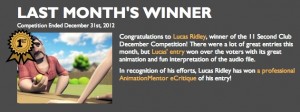UPDATE: Interview with AnimSchool here
UPDATE 2: eCritique by Jean-Denis Haas here
I am very excited I won the 11 Second Club for December 2012! There were some great entries this last month and I did not expect to win.
I first heard of the competition in school about a year and a half ago when our instructor advised us not to enter, because, as students, he didn’t want us to get ahead of ourselves by trying to do subtle character acting when we were still trying to master a bouncing ball. That was great advice then, but made me more intrigued to enter when I was ready for it! I first entered when I graduated school, about a year ago and got 18th. Over the last year much has happened, that has helped me continue to improve as an animator.
I got the idea for this interpretation of the audio file by brainstorming: what would be interesting to watch someone try and quit? (that’s what the audio was all about in it’s simplest form) If I frame things in a question instead of thinking of brainstorming as a goal I’m trying to reach it makes that process easier for me.
I thought of a rock band, being a cowboy, or a thief. Then I tried to think what would be more humorous and landed on the idea of two old geezers working a lemonade stand their whole life and one is really into it and the other wants to ‘move on.’
I came close to not entering this month and almost gave up on the animation when I was half-way through finishing. I took my blocking phase pretty far and when I hit spline on my stepped keys of my second character, it looked absolutely horrible. He was wobbling all over the place in that initial head move, nothing was working. I realized how much work with him I had left to do. And feeling discouraged, I turned off my computer thinking I was just going to have to give up on this one. After all, I have my full time job and a commitment to LEGO to film some web spots for them I needed to focus on.
Stepping away from my computer and taking a break over Christmas was what I needed to get motivated to attack this animation again. Instead of getting overwhelmed with how much work it was going to take to get this animation to a decent place, I refocused and set small goals and completely forgot about trying to meet the oncoming deadline for the competition: Tonight, I am only going to focus on the breakdowns between these four poses.
That allowed me to take small bites and deal with each problem as it came, instead of trying to juggle all these problems in my head at the same time.
These are the takes I used for reference:
I was surprised with what I got away with while I was animating and it to not feel odd when it’s played, but if you freeze frame, it’s fairly extreme. That’s one thing I love about animation, being able to feel something happening without being able to actually see it because it happens over only one or two frames. But even if we can’t see it, it still imprints on us.
I was having a hard time getting the second guy’s lipsync to read since his head was moving around so much I had to purse his lips pretty far, check out frame 227, or his eyes stretched in 231, or his mouth in 272, all of these kind of look ridiculous as a single frame . I enjoyed playing with that extreme to see how far I could go and it still work. Maybe I could have gone further with it. I’m really looking forward to watching the critique!
That’s another thing I love about animation: it’s a reward to get a critique. How many other professions are you rewarded with a critique? In animation it’s a privilege for someone to take their time to give you their opinion to try and help you improve. I really appreciate that about this craft.
While I was in Vancouver Film School hearing constant critiques of mine and my classmate’s work was one of the most valuable aspects of school. And watching the eCritiques has taught me so much. In this animation I already know the areas I think are weak and could be improved on, but I’m really interested to hear an outsider’s considered opinion.
I think the first guy could use a lot of work, all of his animation is a bit soft. The second guy has some subtle hitches in his movement I’d like to smooth out, his head is still a bit weird, his torso animation could be improved, as well as his shoulders . . . I’ve never used animation layers, but I may attempt to make those corrections after hearing what the critique is like using animation layers.
To summarize here are the things I learned doing this animation (the whole reason I did it was to learn more!):
- Trying to answer a question is an easier way for me to brainstorm
- Breaks can be a very valuable way to spend time (instead of banging my head against the computer and calling that ‘work’)
- Take small bites and simplify
- After blocking, leave the reference mostly behind and focus on making the animation work
And a special thanks to my friend Dylan for letting me use one of his rigs (the first character) – here’s the short film that rig is from that Dylan and Logan made.


That is a damn fine piece of animation. Very well done. Love the subtleties.
hey there! just wondering where you got your character rigs? I love that guy in the plaid
Devanie
well just found my answer! duh if I read your hole post I would have known that!